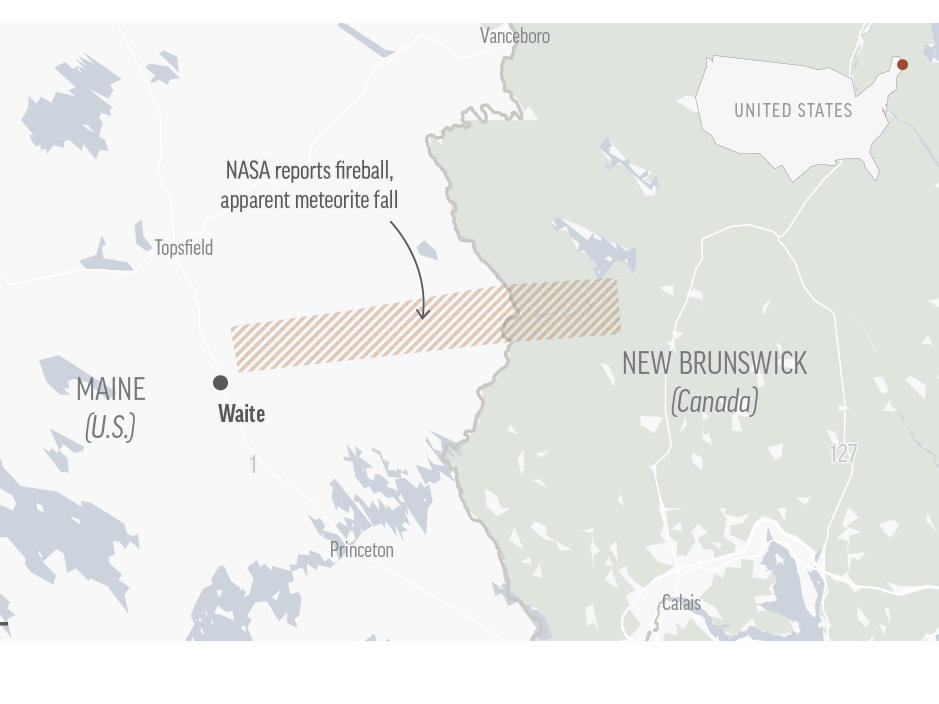Section Branding
Header Content
A rare fireball flew over Maine. Now there's a $25K reward for pieces of space rock
Primary Content
A rare fireball was spotted streaking across the northern Maine sky in broad daylight last week. Experts hoping to study the meteorite are now offering a financial reward to anyone who can recover a piece of it.
NASA says this was the first radar-observed meteorite fall ever seen in Maine. Shortly before noon on Saturday, eyewitnesses reported seeing a bright fireball over New Brunswick, Canada, followed by "loud sonic booms" near Calais, Maine.
That's especially unusual because most fireballs are spotted during the night, when their light contrasts against the dark sky, as the Maine Mineral and Gem Museum noted in a Wednesday Facebook post.
"This fireball being seen during the day is incredibly rare; imagine how bright it would have been at night," it added.
Using radar, NASA was able to detect that meteorites had fallen and calculate where they may have landed, noting that strong winds of up to 100 miles per hour carried smaller ones across the border into Canada.
The mile-wide "strewn field" stretches from just north of Waite, Maine, to Canoose, New Brunswick. And the mineral museum is encouraging people to go explore it.
"The existence of positive Doppler radar returns — meteorites detected descending through the atmosphere just several miles above ground — assures us there are meteorites waiting to be found," Darryl Pitt, chair of the museum's meteorite division, said in a Monday release.
The museum, which is home to the world's largest specimens of the moon and Mars, is offering $25,000 for the first 1 kilogram of meteorite found — but is willing to purchase other fragments, too.
"Depending upon the type of meteorite this is, specimens could easily be worth their weight in gold," said Pitt.
The museum says people are most likely to find specimens "directly west of Canoose straddling the border," and that the reward is also open to Canadians.
And there are a few things officials want people to know before they set out to search.
For one, the museum's research lab technologist is able to test specimens for identification by appointment only, a process that costs money and takes five-10 business days to yield results.
The museum advises first-time hunters to do some online research first so they know what they're looking for — and warns everyone to take the appropriate precautions.
"Needless to say," it adds, "one must obtain permission to hunt on private property."
What to look for
Finding meteorites is no easy task.
Pitt told CNN that only eight to 10 out of the hundreds of meteorites seen falling to Earth each year are recovered. In fact, this same museum offered a $20,000 reward for meteor fragments back in 2016 and didn't get any.
But Pitt says he's more optimistic this time around, especially because there's more detailed information available from NASA's radar data.
So what should meteorite hunters look for? The museum says chemical composition testing is the most definitive way to know what they've found, but there are clues that can point them in the right direction.
Meteorites tend to be heavy and magnetic, with shallow depressions (but not holes) on their surface and densely packed interiors. They can be irregularly shaped, and usually have a smooth rather than scratchy exterior.
Experts at the University of Alberta recommend these four tests: Check if the specimen feels unusually heavy for its size, test its magnetism using a refrigerator magnet, check for holes and bubbles, and examine the outer layer for a thin, black eggshell-like crust.
If the rock passes all four, it may be a meteorite. But it may not be from Saturday's fireball, as the museum warns: "Specimens exhibiting advanced botanical matter are not from this fireball event!"
Copyright 2023 NPR. To see more, visit https://www.npr.org.

